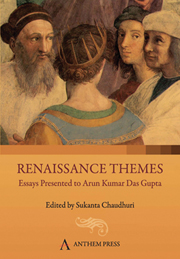Book contents
- Frontmatter
- Contents
- Preface
- List of Contributors
- Arun Kumar Das Gupta
- The Renaissance God as Man of Letters
- Ramist and Senecan Elements in Joseph Hall's The Art of Divine Meditation
- Hypocrite Lecteur: Reading on the Early Modern Stage
- Vertigo
- Folly and Androgyny: Shakespeare's King Lear
- ‘Fatal Visions’ in Macbeth
- The Miltonic Dissimile: Language and Style in Paradise Lost, Book 4
- ‘A Moving Grave’: Positioning Samson Agonistes
- Plate section
Ramist and Senecan Elements in Joseph Hall's The Art of Divine Meditation
Published online by Cambridge University Press: 05 March 2012
- Frontmatter
- Contents
- Preface
- List of Contributors
- Arun Kumar Das Gupta
- The Renaissance God as Man of Letters
- Ramist and Senecan Elements in Joseph Hall's The Art of Divine Meditation
- Hypocrite Lecteur: Reading on the Early Modern Stage
- Vertigo
- Folly and Androgyny: Shakespeare's King Lear
- ‘Fatal Visions’ in Macbeth
- The Miltonic Dissimile: Language and Style in Paradise Lost, Book 4
- ‘A Moving Grave’: Positioning Samson Agonistes
- Plate section
Summary
This paper offers a reading of Joseph Hall's The Art of Divine Meditation as a Ramist treatise, analysing his rhetorical and stylistic practice. But it might be appropriate to begin with a general comment on the meditational exercise as a genre. Louis L Martz has demonstrated how the Protestant arts of meditation came into being in reaction to an intellectual movement fostered by the Catholic Reformation, and particularly by the Jesuit fathers. One of the best fruits of this movement was the Spiritual Exercises of St. Ignatius Loyola. Its impact was felt all over Europe through a number of Jesuit treatises and manuals that followed in its wake, St François de Sales's Introduction à la vie dévote being a particularly influential one.
In a manual published in the nineteenth century, we are given in simple terms the procedure involved in an Ignatian meditation:
The immediate preparation consists in
Placing ourselves in a special way in the presence of God. St. Ignatius recommends that we stand for the space of an Our Father.
In a prayer to ask grace to make the meditation well, and in this prayer to make a little act of self-humiliation, and be sure to invoke our Lady and St Joseph.
Then follow the preludes and the points of meditation. After reading each point we should reflect.
If we find in the first or second point sufficient matter for meditation, we are not obliged to go on further. […]
- Type
- Chapter
- Information
- Renaissance ThemesEssays Presented to Arun Kumar Das Gupta, pp. 17 - 32Publisher: Anthem PressPrint publication year: 2009



